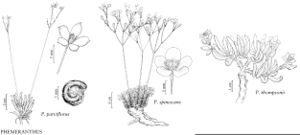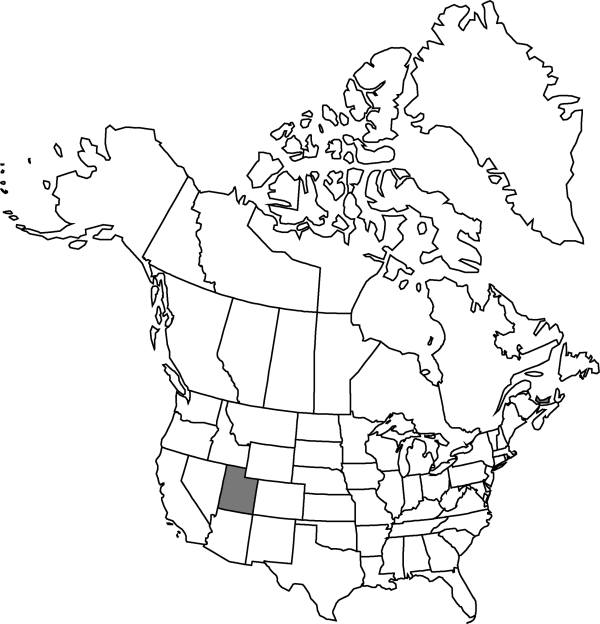Difference between revisions of "Phemeranthus thompsonii"
Novon 11: 321. 2001.
FNA>Volume Importer |
imported>Volume Importer |
||
| (7 intermediate revisions by 2 users not shown) | |||
| Line 7: | Line 7: | ||
|year=2001 | |year=2001 | ||
}} | }} | ||
| − | |basionyms={{Treatment/ID/ | + | |special_status={{Treatment/ID/Special_status |
| + | |code=F | ||
| + | |label=Illustrated | ||
| + | }}{{Treatment/ID/Special_status | ||
| + | |code=E | ||
| + | |label=Endemic | ||
| + | }}{{Treatment/ID/Special_status | ||
| + | |code=C | ||
| + | |label=Conservation concern | ||
| + | }} | ||
| + | |basionyms={{Treatment/ID/Basionym | ||
|name=Talinum thompsonii | |name=Talinum thompsonii | ||
|authority=N. D. Atwood & S. L. Welsh | |authority=N. D. Atwood & S. L. Welsh | ||
| + | |rank=species | ||
| + | |publication_title=Great Basin Naturalist | ||
| + | |publication_place=45: 485, fi g. 1. 1985 | ||
}} | }} | ||
|synonyms= | |synonyms= | ||
| Line 19: | Line 32: | ||
}}<!-- | }}<!-- | ||
| − | --><span class="statement" id="st- | + | --><span class="statement" id="st-undefined" data-properties=""><b>Plants </b>to 5 dm; roots tuberous, fleshily woody. <b>Stems</b> spreading-ascending, branching, suffrutescent. <b>Leaves</b> sessile; blade subterete, to 3.5 cm. <b>Inflorescences</b> cymose, overtopping leaves; peduncle not scapelike, to 1 cm. <b>Flowers</b>: sepals persistent, ovate, to 5 mm; petals pink, obovate, to 8 mm, apex short-acuminate; stamens 10; stigma 1, capitate. <b>Capsules</b> apically keeled along sutures, ellipsoid, to 6.5 mm. <b>Seeds</b> without arcuate ridges, to 1.3 mm.</span><!-- |
-->{{Treatment/Body | -->{{Treatment/Body | ||
| + | |phenology=Flowering Jul–Aug. | ||
|habitat=Pinyon-juniper and ponderosa pine communities in silicious conglomeritic gravel | |habitat=Pinyon-juniper and ponderosa pine communities in silicious conglomeritic gravel | ||
|elevation=2000-2500 m | |elevation=2000-2500 m | ||
|distribution=Utah. | |distribution=Utah. | ||
|discussion=<p>Of conservation concern.</p><!-- | |discussion=<p>Of conservation concern.</p><!-- | ||
| − | --><p>Phemeranthus thompsonii is known only from Emery County. It is very similar to, and perhaps should be merged with, P. validulus, from which it differs mainly in having much shorter peduncles. When originally described, P. thompsonii was thought to differ also in having fewer stamens and longer leaves and petals, but in fact P. validulus sometimes has as few as six stamens, and has maximum leaf and petal lengths greater than those found in P. thompsonii.</p> | + | --><p><i>Phemeranthus thompsonii</i> is known only from Emery County. It is very similar to, and perhaps should be merged with, <i>P. validulus</i>, from which it differs mainly in having much shorter peduncles. When originally described, <i>P. thompsonii</i> was thought to differ also in having fewer stamens and longer leaves and petals, but in fact <i>P. validulus</i> sometimes has as few as six stamens, and has maximum leaf and petal lengths greater than those found in <i>P. thompsonii</i>.</p> |
|tables= | |tables= | ||
|references= | |references= | ||
| Line 35: | Line 49: | ||
-->{{#Taxon: | -->{{#Taxon: | ||
name=Phemeranthus thompsonii | name=Phemeranthus thompsonii | ||
| − | |||
|authority=(N. D. Atwood & S. L. Welsh) Kiger | |authority=(N. D. Atwood & S. L. Welsh) Kiger | ||
|rank=species | |rank=species | ||
| Line 42: | Line 55: | ||
|basionyms=Talinum thompsonii | |basionyms=Talinum thompsonii | ||
|family=Portulacaceae | |family=Portulacaceae | ||
| + | |phenology=Flowering Jul–Aug. | ||
|habitat=Pinyon-juniper and ponderosa pine communities in silicious conglomeritic gravel | |habitat=Pinyon-juniper and ponderosa pine communities in silicious conglomeritic gravel | ||
|elevation=2000-2500 m | |elevation=2000-2500 m | ||
| Line 48: | Line 62: | ||
|publication title=Novon | |publication title=Novon | ||
|publication year=2001 | |publication year=2001 | ||
| − | |special status= | + | |special status=Illustrated;Endemic;Conservation concern |
| − | |source xml=https:// | + | |source xml=https://bitbucket.org/aafc-mbb/fna-data-curation/src/2e0870ddd59836b60bcf96646a41e87ea5a5943a/coarse_grained_fna_xml/V4/V4_1008.xml |
|genus=Phemeranthus | |genus=Phemeranthus | ||
|species=Phemeranthus thompsonii | |species=Phemeranthus thompsonii | ||
| − | |||
| − | |||
| − | |||
| − | |||
| − | |||
| − | |||
| − | |||
| − | |||
| − | |||
| − | |||
| − | |||
| − | |||
| − | |||
| − | |||
| − | |||
| − | |||
| − | |||
| − | |||
| − | |||
| − | |||
| − | |||
| − | |||
| − | |||
| − | |||
| − | |||
| − | |||
}}<!-- | }}<!-- | ||
-->[[Category:Treatment]][[Category:Phemeranthus]] | -->[[Category:Treatment]][[Category:Phemeranthus]] | ||
Latest revision as of 21:56, 5 November 2020
Plants to 5 dm; roots tuberous, fleshily woody. Stems spreading-ascending, branching, suffrutescent. Leaves sessile; blade subterete, to 3.5 cm. Inflorescences cymose, overtopping leaves; peduncle not scapelike, to 1 cm. Flowers: sepals persistent, ovate, to 5 mm; petals pink, obovate, to 8 mm, apex short-acuminate; stamens 10; stigma 1, capitate. Capsules apically keeled along sutures, ellipsoid, to 6.5 mm. Seeds without arcuate ridges, to 1.3 mm.
Phenology: Flowering Jul–Aug.
Habitat: Pinyon-juniper and ponderosa pine communities in silicious conglomeritic gravel
Elevation: 2000-2500 m
Discussion
Of conservation concern.
Phemeranthus thompsonii is known only from Emery County. It is very similar to, and perhaps should be merged with, P. validulus, from which it differs mainly in having much shorter peduncles. When originally described, P. thompsonii was thought to differ also in having fewer stamens and longer leaves and petals, but in fact P. validulus sometimes has as few as six stamens, and has maximum leaf and petal lengths greater than those found in P. thompsonii.
Selected References
None.

